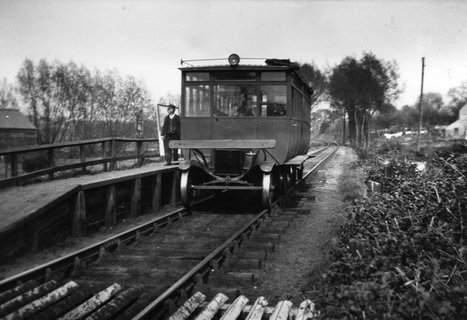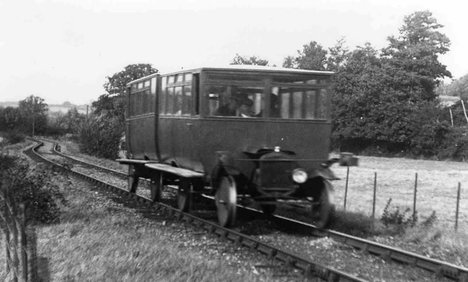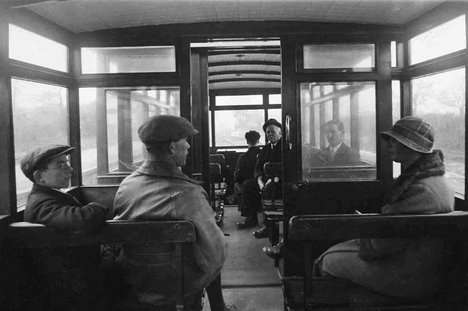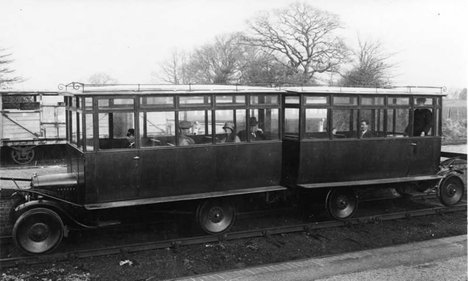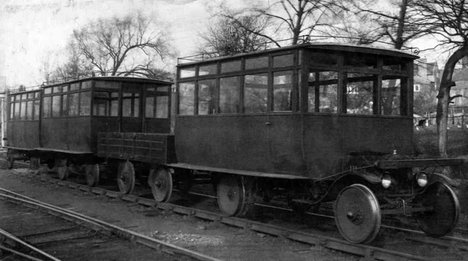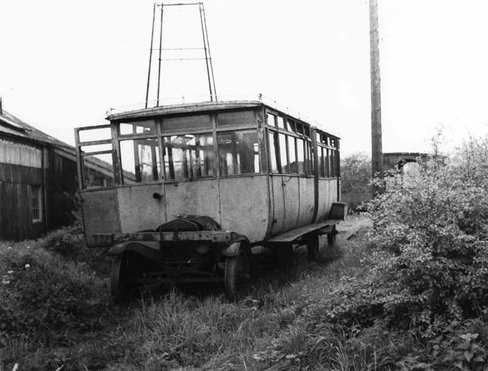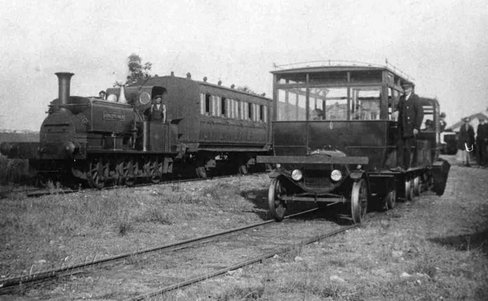Museum
Topics
Ford Railmotors
The History Of Stephens' Characteristic Pioneering Railmotors
Part 1
Origins
Holman Stephens passionately believed in light railways to serve the needs of rural communities and that to succeed they must be built and run at low cost. However, even the smallest conventional steam engines were expensive items to buy and run. Stephens on building his first independent railway, the Rye and Camber, told the responsible authorities that he wished to use ‘an oil motor on a bogie passenger car' to operate the service. This was a step too far for the internal combustion engine was less than ten years old and Stephens was unable to realise his ambition. A small steam locomotive had to be used.
Ten years later he returned with another innovation, a light steam railmotor. However it proved mechanically unreliable and increasing traffic and the First World War brought the experiment to an end. During the First World War petrol road lorry and bus development leapt forward and traffic on rural railways was under threat. To help counter this Stephens returned to the new technology. A first experiment was in October 1921 on the Weston Clevedon and Portishead but the vehicles were effectively hand built one-off products and therefore expensive; too expensive to adopt on cash starved independent light railways.
Stephens had begun experimenting on the Kent & East Sussex at some time before 1921 with a cheaper alternative using an Edwardian Wolseley-Siddeley car chassis that was adapted as a rail lorry and then as a bus. In using such adaptations Stephens was in the forefront of world practice, for only a few lines in North America and one French manufacturer were trying such things at the time. Little is known about the success or otherwise of this vehicle in service which, although single ended, was equipped with some form of reverse and a rear radiator. It was moved at an early date to the Selsey Tramway, where it certainly saw some use, and then about 1928 went to the Shropshire & Montgomeryshire where it saw little use. However, its body on another chassis continued in use as a light coach for use with the locomotive Gazelle till sometime during WW2, probably in late1942.
Never discouraged, Stephens then bought some cheap mass produced 1 ton lorry chassis (part of the Model T family) with bus bodies on them. To avoid the reversing problem, he used them in back-to -back pairs. This was a little wasteful in that the leading car had to pull the trailing car which, although out of gear, was an unnecessary deadweight, but obviated the need to have a reverse gearbox or turn the car.
K&ESR No. 2 at Junction Road
K&ESR No.1
K&ESR No. 2 interior
K&ESR No, 2 when new
The first set was delivered to the Kent and East Sussex sometime in late 1922, being described and illustrated in the Commercial Motor magazine of 12 December of that year. Later, in September 1923, Stephens wrote to the same magazine saying ‘I have nine small steam railways under my control and am trying several forms of motor trains.... In a previous experiment I learnt, to my sorrow, that it is cheaper to have a car at each end than to put in a reverse gear.' Col. Stephens gave his reason for choosing Ford chassis as follows: ‘The motive units are the much despised 1-ton Fords; we chose this type, as we can always get spares without delay and for no other reason'
The units were built on the lorry chassis with the standard bonnet and mudguards retained complete with sidelights, although these soon disappeared. Two headlamps were initially fitted and it is thought that one could be shaded red for reverse running. Again these progressively disappeared usually leaving only one operational, which in the case of the K&ESR units was moved to centre of the roof. A light weight wooden buffer bar was positioned above and in front of the headlamps although the height and style of this fitting varied over the years. There were no couplings at the leading ends until the second K&ESR set had its buffer bar lowered and couplings fitted to tow a trailer in the late 1920s.The units were connected by centre buffers with a single link and pin. The normal springing for contemporary road vehicles was retained without shock absorbers and with simple stops on the rear axle resulting in often excessive roll. They were fitted with pressed-steel solid disc wheels, probably supplied by Lynton Wheel and Tyre Co, Longford Bridge, Warrington; except on the Selsey motor which initially was fitted with cast steel 8 curved spoked wheels that were subsequently changed to standard on its leading axles. Later replacement disc wheels were probably cast steel and had three holes through the disc like later wagon wheels.
The bodies were very much too contemporary small rural bus standards built from Teak, reinforced by metal plates and with sheet metal covering below the waistline. Livery was that of the contemporary carriages on the lines and which was dark brown, and on the S&MR dark blue. All except the first carried a single luggage rail, with decorative scroll at the two front corners, which became notable for its lack of use. Of five-bay construction with large windows with an opening toplight hinged at their bottom edge to open inwards (originally not on the rear bay of the first railmotor), the opening door on the front panel on either side was set back very slightly from the front, leaving a very short window with a matching toplight at the front. The front and rear doors boasted droplights. Beneath the waistline the tumblehome curved down to a foot-board which ran the full length of the body. The front window was divided into three (two in the first) equal sections with toplights, whilst the rear end was of similar design but with a sliding door in the centre. There were reversible seats for 20 passengers made up of narrow wooden slats with backrests consisting of a 4in strip of wood attached to an iron frame that was itself attached to the base of the seat. The bodywork of the first and probably subsequent units was by Eton Coachworks of Cringleford, near Norwich, Norfolk and the whole set supplied by Edmunds of Thetford, Norfolk.
Warning systems consisted of an electric horn on the steering column and latterly at least an exhaust whistle operated by foot which was connected to a tubular whistle by a length of wire, and normally held away from the exhaust pipe by a spring. A third device, a clearly visible klaxon, also appears to have been fitted to the S&MR set and may have been fitted to the others, but visual evidence is lacking. A foot pedal worked a band brake on the transmission and a hand brake applied a pair of cast-iron shoes to the front pair of wheels. It was customary for the conductor/guard to travel in the rear unit where he could apply the hand brake in an emergency. With their light design, wheel spin was a problem, so a sand bucket was placed either side of the driver's seat and an iron pipe, topped with a funnel, went through the floor to a shute in front of the rear wheels.
The driving position was soon set at a slightly lower level than the passengers (see below) and the steering column remained in place (minus the steering wheel) upon which was mounted the hand-operated advance and retard spark lever on the left and the hand throttle to the right. Foot controls were simple with three identical foot pedals, from left to right: low-neutral-high forward drive, reverse, and transmission brake. The hand brake when applied stopped the left-hand pedal at neutral as well as operating the brake shoes on the front wheels.
The petrol tank was originally under the driver's seat and filled directly. This had two disadvantages; the fumes leaked through the filler cap (this did not matter in the road lorries which had open cabs but was unpleasant in the enclosed railmotor bodies) and it caused the seat to be mounted too high for some drivers, who could not reach the pedals. The fuel tanks were subsequently moved outside and strapped on the running board just to the rear of the entry door. The consequent lowering of the driver's seat caused the odd effect of the driver sitting far lower than his passengers.
The gearbox was the normal 3 speed Epicyclic Ford unit operated by the pedals described, but subsequent railmotors were fitted with the Supaphord Patented Auxiliary Gear Box which gave an extra two forward and one reverse gear, and enabled a better freewheel when the rear unit was being towed.
Sanding in slippery conditions was achieved by a simple ‘sanding chute’ directing sand to the rear wheels and fed by hand by the guard from the floor of the coach.
Kent & East Sussex Railway
The first Ford railmotor was allocated to the K&ESR and probably commenced normal service on Thursday 15 February 1923. Such was the novelty of these vehicles that even the recently born cinema pictured the phenomena. A Pathe News film is still available that shows the railmotor as it first entered service on the Kent & East Sussex Railway.
Some information is available giving service details for the first few months of service closing on June 9th, listing in passing service failures (although unfortunately not specifying the reasons) and the trains on which those failures occurred. The Railmotors appear to have been used during the trial period to directly replace steam services. They worked the 7.06 am train from Tenterden Town to Robertsbridge Junction returning to Headcorn at 8.18. On leaving Headcorn at 9.51 they reached Tenterden at 10.23, travelling on to Robertsbridge at 10.40 with arrival there at 11.22. Departing at 11.40 to Tenterden, on arrival at 12.25 they were relieved by a steam train for the reminder of the Headcorn run. This was the end of their Saturday turn. On weekdays they left at 3.50 for a Headcorn trip arriving back at Tenterden at 5.05. The daily weekday mileage given for this was 93 miles 14 chains which will have included an empty stock run from Rolvenden to Tenterden and return each day. Saturday workings omitted the Headcorn run so totalled 74 miles 6 chains (no Sunday trains ran).
The first failures occurred on 26th and 27th February 1923 when on both days the motors could only complete the first round trip to Robertsbridge. Two weeks later on 14th March a more serious in-service failure occurred when the set failed and was unable to do the last Headcorn run. It was out of service for two days, and then failed again the next day at Rolvenden on the first trip before it could complete the run up the bank to Tenterden. It did not work at all the next day (the 19th) and on the 21st did not start to run till the afternoon. Caution and perhaps traffic levels then dictated that it should not run over Easter (28th March to 6th April) as no entries were made. Although the railmotor then resumed its normal roster, oil consumption had been rising during the latter part of May and continued to rise reaching some 50% above previous levels. Enough was enough and they were taken out of service for a week commencing 21st April.
There might have been a myriad of reasons for individual failures but the problems of March and April seem to have been due to the carbonising of the engines. An analysis of the lubricating oil was sought from David Kirkaldy & Sons, Testing and Experimenting Works, 99 Southwark Street, London and a report dated 28th May 1923 stated "This sample is a light mineral oil of good quality though the flash point is somewhat low. It is of too low a viscosity for general use in petrol engines... and would only be suitable for those employing a splash system of lubrication. The addition of about 5% of non-drying fixed oil such as lard is desirable, tending to reduce the liability to carbonise in the cylinder."
A de-coke and change of oil seems to have done the trick. The set returned to service with one round trip on 30th April and settled down in regular service with petrol and oil consumption reduced for the rest of the trials, the records for which terminated on June 9th.
The railmotors having proved themselves they were then used to establish a new service pattern on the Railway that was shown in Bradshaw for July 1923. The set was used to supplement the existing somewhat minimalist steam services established during World War 1. In this it now followed the classic pattern of railmotor use by increasing service frequencies in an attempt to counter competition from road based transport. In the July timetable the railmotors were shown as working the 9.20am train from Tenterden Town to Robertsbridge Junction returning to Headcorn at 10.20. On leaving Headcorn at 11.55 they reached Tenterden at 12.35pm and travelled on to Robertsbridge at 1.20 with arrival at 2.10; returning at 2.25 (2.45 on Saturdays) to Tenterden. On weekdays they then substituted, as they had during the trials, for a previously steam service which left at 3.50 for a Headcorn return trip arriving back at 5.05. This finished their weekday service but on Saturday and Wednesday they finished with an evening round trip to Headcorn.
This augmented service was a bold and much needed marketing effort. Bus competition had been serious enough to warrant mention in annual reports as early as 1913. In that year 105,000 passengers were carried, by 1919 the figure had dropped to 85,000 and to 68,000 in 1922. With the coming of the railmotors the 1923 total train mileage leapt by nearly 25% to 84000 miles, marginally surpassing pre-war levels. The railmotors accounted for all of this and more. These high total mileages were maintained until in 1932 the railway went into receivership and services were cut to the bone. Initially therefore the Railmotors were not used simply to cut overall running costs but to control increased costs in the expectation of increased receipts. For the struggling Headcorn section however some savings were urgent and the motors continued to be used to replace obviously unremunerative steam runs.
A second railmotor set was delivered in April 1924, to the same general bodywork and mechanical layout as the S&MR one. The builder was Edmonds of Thetford and it cost £542/17/- and payment was by 12 monthly payments of £45/4/9. With the addition of this unit cost savings became increasingly attractive and the railmotors slowly took over more steam mileage, generally around a third of all mileage on the K &ESR at a little short of 30,000 miles each year. Indeed during 1926 with a prolonged coal strike and the General Strike the railmotors accounted for well over half the services.
Despite initial success the railmotors on the K&ESR had not been able to staunch the haemorrhage of passengers. Holding steady briefly in 1923 passenger numbers continued to decline and although they recovered slightly in the later 1920s they had by then reduced to half the 1919 levels. With the railway passing into receivership in 1932 the end of the experiment was in sight. Annual passenger numbers fell precipitately to 20,000. After a very few years the very light construction of the Ford railmotors told against them. And as usual with internal combustion machines at that date depreciation was rapid. Tellingly too the rapid technical progress and increasing comfort of competing buses told against them. As passengers deserted to the more comfortable and frequent buses and steam was needed to move the goods, railmotor mileage never again exceeded 14,000 a year.
Carrying the minor drawbacks of all pioneers the first set was the first casualty and seems likely to have fallen out of use in about 1931, and was withdrawn by July 1932 with one body sold on 30th July for £1/10/- ( £1.50) with the remaining one sold on 26th January 1935 for 10/- ( 50p). The second set soldiered on until 17th August 1937 but lingered on at Rolvenden with the bodies sold on 1st and 8th August 1939. The chassis lingered on for a while to disappear in war scrap drives.
Part 2
The Shropshire & Montgomeryshire
In 1923 a railmotor was introduced on the Shropshire and Montgomeryshire Railway.
The Locomotive Magazine reported the introduction of this railmotor set in its issue of 15th September 1923:
'For passenger service a three car motor train ... has been put into traffic by Col H F Stephens, on the Shropshire & Montgomeryshire Railway (Shrewsbury to Llanymynech). These interesting adaptations of road motors for rail service are arranged back to back, with an intermediate dummy car in the centre, giving accommodation in all for sixty passengers. Light passenger bodies have been fitted on the motor car frames; the usual steering gear dismantled, and flanged wheels fitted to solid axles. A sliding door at the rear of each body provides access to the centre car.
Centre drawpin connections are used for coupling the cars. The train maintains a good average speed, the economical rate being about 25 miles per hour, but it will run faster. It will climb gradients of 1 in 50 with 9 chains curves quite easily, and manages long stretches of 1 in 130 and 1 in 150 without overheating. It is early to give figures at present, but on trial the train ran 50 miles on 7 gallons of petrol with three cars, or working as a two-car unit just over 1½ gallons of petrol for 18 miles, the load being made up with bags of coal, etc., to the full complement of passengers. When running the gear of the rear car is placed in neutral.
The railmotor although identical with the second K&ESR set had an intermediate third passenger trailer. There are very few photographs showing the set running with the trailer and it seems to have proved short lived in service not only because of limited haulage power but with falling passenger numbers steam stand-ins for busy market days probably rendered it useless in normal service . The trailer remained on the books till 1930 but ended up on the Selsey which was at least relatively flat. There is however no hard evidence of its use there.
Initially the railmotor seems to have been used to supplement the existing, mixed train, steam services to provide a better service but passenger numbers had been falling after the boom years of 1920/21 and with the General and coal strikes and intense bus competition this could not be sustained. Steam mileage fell by one half with the railmotor mileage increasing to double its 1925 level by 1927. Although the published traffic statistics are a little unclear, it would appear that only one mixed steam service per day remained thereafter ( excluding the occasional shuttle by Gazelle on the Criggion branch). The railmotor appears to have been asked to sustain three round trips a day during this period, possibly the reason why the Wolseley -Siddley and the Ford rail lorry were drafted in from the Selsey Tramway though they were clearly of limited use. Some services were operated by one of the Fords, coupled to the rail lorry. This would have enabled services to be maintained when one of the powered cars needed overhaul. Despite a sustained level of railmotor services in 1927, 1928 and 1929 passenger numbers were in very steep decline and fell from 50K in 1923 and 28K in 1926 to 11K in 1931.
An entry in the Directors' Minute Book for 23rd September 1930 recorded that the railcars had been de-railed and badly damaged, and that the line was being entirely worked by steam. A further entry on 26th November recorded that the railcar driver had been dismissed and that the Railway might dispense with railcars altogether. It is perhaps significant that the intermediate trailer was withdrawn during 1930; it may simply have been surplus to the line's requirements by this date. The Directors ultimately decided not to dispense with the railmotors and they had returned to service by March 1931 when it was reported that they were using more petrol even though they were running fewer services.
The S&MR railmotor
The Selsey Tram
Probably the line most affected by the introduction of railmotors was the Selsey tram with its incredibly light track and relatively frequent services. The first railmotor to arrive was the Wolseley-Siddeley which according to newspaper reports seems to have entered service on 11 March 1924 and at least initially operated singly. The Selsey's own railmotor, with some minor changes from the earlier railmotors and cast steel spoked wheels, arrived by the beginning of July and was to prove the last of Stephens' Ford railmotors. It enabled a slight enhancement of services with an extra 2 services each day and relegated steam to one mixed train a day, except at peak periods .This pattern, with a suitable reduction in winter months, continued for the rest of the line's existence. In many ways these railmotors epitomised the Selsey in its last decade, for good or ill. Reliance on the one motor and the unreliable Worlseley-Siddeley did however cause considerable pressure on reliability, which was soon reportedly poor, and it was not unknown for the railmotor to be split and operate as a single - a somewhat hazardous proceeding which probably persisted until the arrival of Stephens Shefflex railmotor at the beginning of 1928.
As the Selsey became progressively run down the Fords seem to have become the secondary railmotor, even though joined by the Shropshire and Montgomeryshire middle coach at some time probably in 1930. There is doubt that this supplementary coach was ever used and it had disappeared before the Tramways closure in January 1935. The 2 unit Ford railmotor remained however even though it was reported as poor by the Southern Railway authorities in their 1934 report, and at closure and after standing around in increasingly poor condition was sold with the railway a year later. The successful tenderer then lifted the track and seems to have scrapped the underframes. He finally offered for sale the remaining bits of the railway, including the railmotor bodies, on 30th June 1936 but their fate is unknown.
This led to further consideration of their future and it was decided on 29th April 1932 to discontinue their use and to dismiss the railcar driver, named as Sid Nevett. Mixed trains would operate all services from 30th April. However, a falling off in the Criggion stone traffic and a shortage of serviceable locomotives led the Directors to relent at their meeting on 28th November 1932 when they agreed to allow the railcars to run 'if necessary'. Nevertheless railmotor use was dramatically reduced in 1932 and 1933.
Regular passenger services ended on the S & MR in November 1933 but the railmotor remained available for occasional excursions and the limited services that ran on bank holidays and was much photographed on this work. However a surviving train register shows that the unit was in addition used regularly from December 1934 on what we must assume was parcels or milk services. Operating on every weekday till January 1935 and thereafter on two or three days each week till early August but then mechanical troubles seem to have interceded and operation became increasingly infrequent finally ceasing on 30th July 1936. In 1934 & 1935 mileage was around 2,500 but in 1936 this dropped to 200. It did not work again. Gazelle and its ‘new' trailer had become available to meet the need for occasional light services in June 1937 and the railmotor lay derelict till broken up early in the Second World War, probably late 1941.
Other Railways
The success of the railmotors on the K&ESR prompted further action by other operators with consideration given to use on a Welsh narrow gauge line and a close copy put into service on the Derwent Valley Light Railway in Yorkshire, a railway with close personal connections with Stephens. These railmotors entered service during 1924, equipped with rather superior bodywork. When severe bus competition prematurely terminated their use there is anecdotal evidence that Stephens wanted them for the East Kent Light but in the event they were sold to the County Donegal Joint Railways in Ireland where, re-gauged, they pump-primed a series of very successful railcars that kept the railway open till the late 1950s.
The Railmotors in service
Stephens had good cause to be pleased with the railmotors in the early days. Capital costs were low; reliability and high daily mileages seemed possible and indeed so proved. Average petrol consumption was very good particularly when it is considered that the second unit was always being hauled. Other costs would also have been favourable: one member of the crew was saved, and with no engine preparation needed overtime was no doubt cut on the loco side. Economies could be made and the service supplemented, and if comfort was cut for the passengers then they were certainly no worse off than using the contemporary competing road bus services.
However rapid road vehicle development soon changed this dramatically and bus technology improved by leaps and bounds leaving the Ford railmotors technically obsolescent well before the 1920s were out. Nevertheless lack of capital for replacements did not lead to their final withdrawal from service until the late mid to late 1930s.
Starting at Headcorn
Watering the Selsey railmotor
Colonel Stephens was always enthusiastic about the development of these railmotors although he always designated them experimental. They were however regarded by the operating staff with some trepidation, as their mechanical shortcomings were a constant source of difficulty.
Monty Baker, observer of the Kent & East Sussex in his boyhood and an employee in the Thirties, recalled how difficult a job it was to get from Rolvenden up the bank to Tenterden on a frosty morning or if the rail was at all damp. Only one pair of the eight wheels was powered and on many occasions slipping was so bad that the journey to Tenterden was abandoned; and after a check that no passengers were waiting, the first journey of the day to Robertsbridge would start from Rolvenden.
The Tenterden bank problem was replicated on the S&MR where Shrewsbury Abbey station was the terminus principal station on the line with an immediate1 in 47 gradient outwards. A driver on that line, Clifford Gill, recalled that around 1930 on Shrewsbury Market days these railmotors would have both cars full of passengers and their shopping, so he used to get a young porter to assist in getting the railmotor moving. Shortly before leaving the Abbey station, the porter in the rear car would start the engine, press the reverse gear pedal and open the throttle; thus both cars' engines would be working flat out up the gradient. Nearing the first station where the gradient eased off, the porter would turn off his unit, and get off at that station, presumably walking back.
With no self starters, drivers very quickly learned that having mastered starting, one did not stall it, as this meant setting up all the controls again and leaping off the platform, ducking under the buffer beam, cranking the starting handle, and climbing up on the platform again. This was often repeated several times, with various alterations of ignition and hand throttle positions, before it restarted.
Horse manure for plugging radiators was a vital part of the emergency equipment carried at all times, this also included the spanner which tightened the band drives on the gearbox of the Fords.
The terrific vibration on the radiators caused them to leak a lot, and whilst ample provision was made for carrying a good supply of petrol, an even greater supply of water was necessary. Especially when towing the special parcels trucks overheating and boiling over was a particular problem and thus extra water was vital. The petrol can prominent in many photos was an old one used for carrying water and was always kept in easy reach.
Monty recalls that passenger accommodation was poor, the seats were made up of narrow wooden slats, covered initially by strips of thin carpet tied to the seat with tapes but they usually fell off. Passengers who were brave enough to tolerate the cold (there was no heating on the Fords), usually carried an extra item of clothing to fold up as a cushion. It was known for one driver to conjure up a mat that he had hidden under his own seat, for an elderly lady passenger, or a particularly pretty young one. Even this basic accommodation got worse with age and when the S&MR railmotor was on its last legs on 27th July 1931 Mr V. R. Webster took a trip from Kinnerley Junction to Llanymynech in it of which he later wrote:
‘The motion was nauseating and there was a list on the side on which I was sitting....From the sundry openings in the floor boards, where the gear lever went through, there issued a constant stream of dust, bits of grass, dead flies, dandelion "clocks" and the like, all of which circulated around the inside of the car with great velocity and a goodly quantity of which I later found in my hair, pockets and turn-ups of my trousers.‘
Whatever their many faults these lightweight railmotors were a characteristic feature of the Stephens Railway of the Twenties and Thirties. As a unique feature of the British railway scene these were a pioneering and innovative effort to save costs on rural branch lines. But instead they have come to be seen by many of a later generation as oddities. Certainly in their later years this was probably a correct view but in their own way they showed what self-contained powered railmotors could do to save money and provide a convenient service.
Sources
Colonel Stephens' Railmotors, Stephen Garrett & John Scott Morgan, Irwell Press, 1995
Colonel Stephens Railway Museum Archive
National Archive, S&MLR Board Minutes, RAIL 621/1-2
Tin Lizzies on Rails, Monty Baker, The Tenterden Terrier, No 67 Summer 1995
Monty Baker
Colonel Stephens- A Celebration, K&ESR, 2006
The Selsey Tramway (two volumes), Laurie Cooksey, WSP, 2006
The S&M Ford Railcar, R S Carpenter, British Railway Journal No 63, WSP
The Diaries of V R Webster Part 17, British railway Journal No 72.WSP

